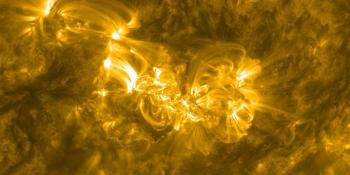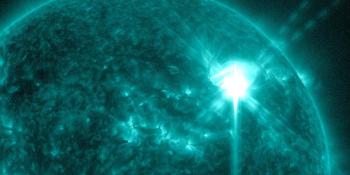Viewing archive of niedziela, 11 lutego 2001
Raport aktywności słonecznej
Any mentioned solar flare in this report has a scaling factor applied by the Space Weather Prediction Center (SWPC). Because of the SWPC scaling factor, solar flares are reported as 42% smaller than for the science quality data. The scaling factor has been removed from our archived solar flare data to reflect the true physical units.
Raport aktywności słoneczno- geomagnetycznej 2001 Feb 11 2200 UTCPrzygotowane przez NOAA © SWPC i przetworzone przez SpaceWeatherLive.com
Połączenie raportów USAF/NOAA o słonecznej i geofizycznej aktywności
Numer SDF 042 wydany w 2200Z na 11 Feb 2001IA. Analiza aktywności regionów słonecznych i aktywność od 10-2100Z do 11-2100Z Solar activity continued low. A C6/1f flare erupted
near the location of spotless plage 9346 (N18W80), at 0123 UTC. A
type II sweep and a halo CME occurred in conjunction with the event.
Region 9338 (S20W28) was still the brightest region in h-alpha, and
produced occasional C-class events. Some minor surging is occurring
at west limb near where Region 9330 (N22W91) is transiting. At east
limb, more impressive surging was seen to accompany the arrival of
newly numbered Region 9350 (N18E69).
IB. Prognoza aktywności słonecznej
Solar activity is expected to be low.
IIA. Podsumowanie aktywności geofizycznej 10-2100Z do 11-2100Z
The geomagnetic field was predominantly quiet to unsettled. However,
brief active conditions occurred from 0600-0900 UTC at Boulder from
a short-lived substorm. An enhancement in the greater than 10 MeV
proton flux at geosynchronous orbit began about 0600 UTC, following
the C6 event at 0123 UTC. The particle increase reached the 1 pfu
level, most recently at 1025 UTC, before the slow decay now
occurring, commenced.
IIB. Prognoza aktywności geofizycznej
The geomagnetic field is
expected to be quiet to unsettled. A glancing blow from today's halo
CME is anticipated mid-to-late in the forecast period, but the
impact on the field should be slight. The greater than 10 MeV
proton flux should return to background levels during the next 24
hours.
III. Prawdopodobieństwa zdarzenia 12 Feb do 14 Feb
| Klasa M | 10% | 10% | 10% |
| Klasa X | 01% | 01% | 01% |
| Proton | 01% | 01% | 01% |
| PCAF | green | ||
IV. Przepływ 10,7 cm z Penticton
Zaobserwowano 11 Feb 151 Przewidywane 12 Feb-14 Feb 150/150/155 Średnia z 90 dni 11 Feb 171
V. Indeks geomagnetyczny A
Zaobserwowano Afr/Ap 10 Feb 004/005 Szacowane Afr/Ap 11 Feb 007/007 Przewidywane Afr/Ap 12 Feb-14 Feb 005/005-005/010-010/010
VI. Prawdopodobieństwa aktywności geomagnetycznej 12 Feb do 14 Feb
| A. Średnie szerokości geograficzne | |||
|---|---|---|---|
| Aktywne | 10% | 10% | 20% |
| Słaba burza | 05% | 05% | 10% |
| Bardzo znacząca burza | 01% | 01% | 05% |
| B. Wysokie szerokości geograficzne | |||
|---|---|---|---|
| Aktywne | 20% | 20% | 30% |
| Słaba burza | 10% | 10% | 20% |
| Bardzo znacząca burza | 01% | 01% | 10% |
<< Idź do codziennego przeglądu
Najnowsze wiadomości
Najnowsze wiadomości z forum
[CME] AR 13664, X1.04, 2024-05-08 63AR3664 310Space Weather Memes 347Filaments and prominences 87Incoming Active Regions 242
Więcej tematówWesprzyj SpaceWeatherLive.com!
Wielu ludzi odwiedza SpaceWeatherLive aby śledzić aktywność słoneczną lub sprawdzić czy jest szansa na zaobserwowanie zorzy polarnej. Niestety, większy ruch na stronie oznacza większe koszty utrzymania serwera. Dlatego, jeśli jesteś zadowolony ze strony SpaceWeatherLive, zachęcamy do wspierania nas finansowo. Dzięki temu będziemy mogli utrzymać naszą stronę.

Fakty na temat pogody kosmicznej
| Ostatnie rozbłyski klasy X | 2024/05/08 | X1.0 |
| Ostatnie rozbłyski klasy M | 2024/05/08 | M9.7 |
| Ostatnia burza geomagnetyczna | 2024/05/06 | Kp5 (G1) |
| Spotless days | |
|---|---|
| Ostatni dzień bez skazy | 2022/06/08 |
| Monthly mean Sunspot Number | |
|---|---|
| kwietnia 2024 | 136.5 +31.6 |
| Last 30 days | 164.7 +73.8 |


